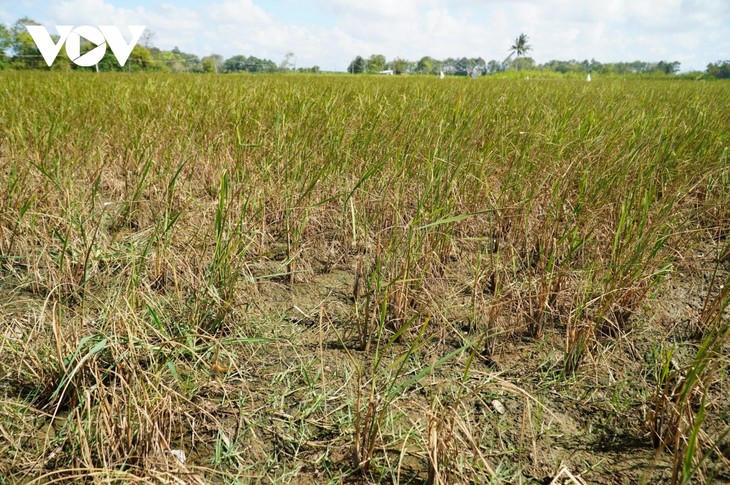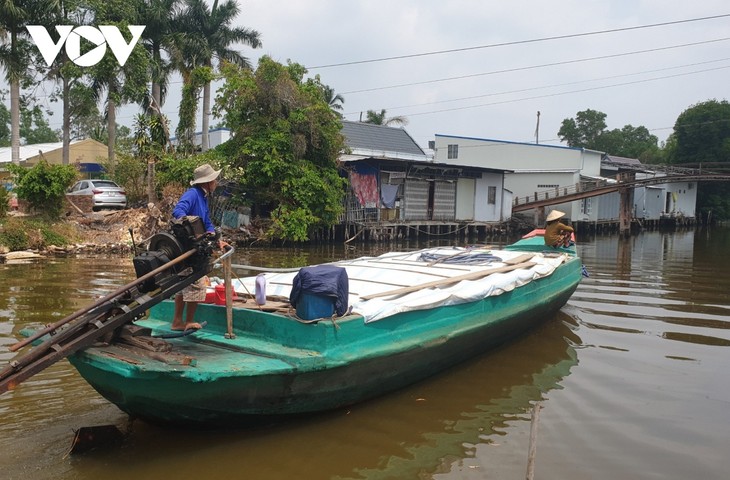(VOVWORLD) - The Mekong Delta is in the most severe drought and saline intrusion period of this year’s dry season. Over the past few months, deep saltwater intrusion has affected agricultural production, freshwater sources, and people's livelihoods. Provinces in the region are putting forth long-term solutions.
 Many rice fields in the Mekong Delta have been affected by the lack of fresh water. Many rice fields in the Mekong Delta have been affected by the lack of fresh water. |
Soc Trang province is having trouble supplying enough water for daily use. Dang Van Ngo, General Director of the Soc Trang Water Supply Company, said as the province is expected to face even greater difficulties caused by surface and underground saltwater intrusion, the company has proposed the construction of a surface water treatment plant with a capacity of 200,000 cubic meters a day, doubling the combined capacity of all plants it is operating currently.
In addition, once the Cai Lon-Cai Be sewer is in operation, it will help regulate water and prevent salinity throughout the region.
By the middle of this year there will be bridges connecting Tien Giang, Ben Tre, and Tra Vinh, creating a coastal belt which will run to Ca Mau via Kien Giang, said Ngo.
“We’ll combine a culvert with a bridge to regulate and retain water during the rainy season for use in the dry season and reduce the pressure of water from upstream,” he noted.
Over the years, people living in the coastal areas of the Mekong Delta region have begun storing water for daily use and restructured production by intercropping rice with shrimp farming to adapt to saltwater intrusion.
According to Associate Professor Le Anh Tuan, scientific advisor to the Research Institute for Climate Change of Can Tho University, there will be a drought-salinity intrusion spell every 4 years which is more severe than the average level.
After making multiple field trips to landslide and subsidence areas in Ca Mau, Tuan underscored the need for more salinity prevention works.
“The current works that prevent salinity have failed to supply enough fresh water. As a result, the soil has shrunk and no longer has counter-pressure, making it more prone to subsidence. So we need better ways to prevent salinity,” Tuan said.
 Ca Mau province is suffering from fresh water shortages for daily use. In the photo, a junk was carrying freshwater to those in need. Ca Mau province is suffering from fresh water shortages for daily use. In the photo, a junk was carrying freshwater to those in need. |
By 2020, there were 18,000 household water wells across the Mekong Delta region. The State has built water supply plants in 13 localities in the region, ensuring enough clean water for urban areas, industrial production, and 30% of the people in rural and coastal areas.
Tran Anh Tuan, Deputy Chairman of the Vietnam Water Supply and Sewerage Association, said the Mekong Delta needs to calculate the water needed for residents, industrial production, and factories in order to develop an interconnected water supply system to serve multiple purposes in the northern and central Tien River region.
The World Bank has approved a plan to build 5 water plants in 3 regions of the Mekong Delta – north of the Tien river, the middle region, and the southwest region of the Hau river.
Mr. Tuan underscored the need to think about supplying fresh water to water plants, adding, “If surface water is salty, we need water pipes to direct water from upstream sections of the Tien and Hau rivers to treatment plants.”
The urbanisation rate of the Mekong Delta is forecast to be 45% of its population by 2030. Construction of a freshwater storage system and inter-regional water supply projects is needed to ensure social security, production, and the daily life of local people and businesses.